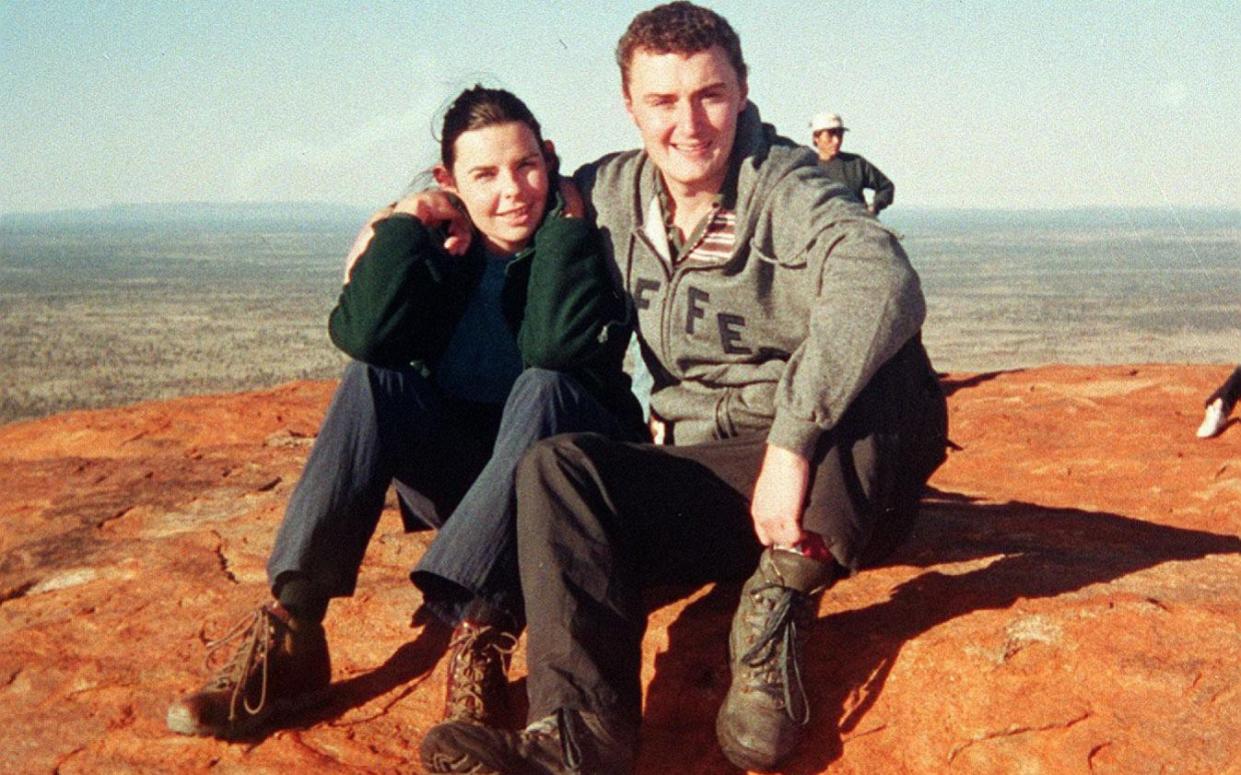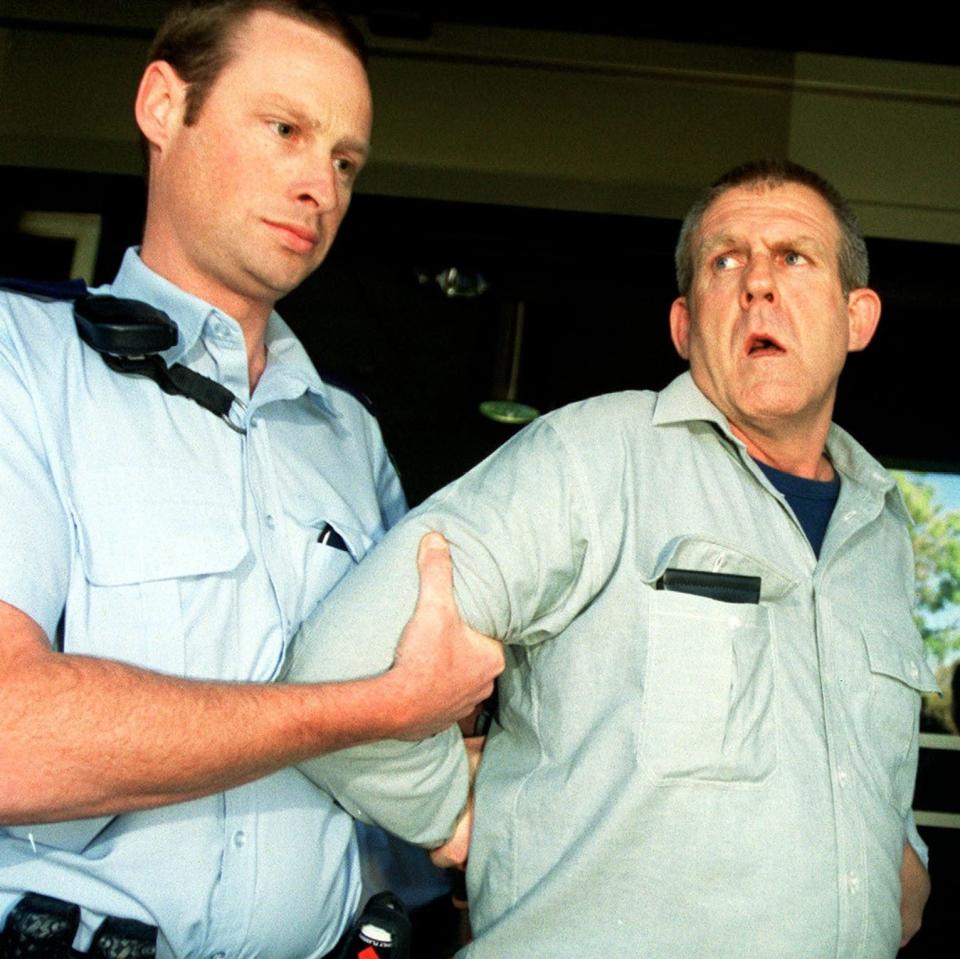'I've spent 60 hours with the man who killed Peter Falconio – and I'm still not certain he did it'


The names Peter Falconio, Joanne Lees and Bradley John Murdoch are now part of Australian folklore. In July 2001, two young British backpackers, driving their VW camper van on a lonely stretch of outback highway, were persuaded to pull over by Murdoch, a passing truck driver, a decision that ended with 28-year-old Falconio being shot dead and Lees, then 27, being tied up, in anticipation of being raped, before she made a miraculous escape into the bush. Their story is the subject of Murder in the Outback, a four-part Channel 4 documentary that concludes tomorrow.
A friend said: “You should do a book about it. It’s got everything: a wicked gunman, the murder of an innocent backpacker, a brave girl who eludes her boyfriend’s murderer, rescue by a passing truckie, police crashing round the crime scene… and the Barrow Creek pub acting as police headquarters.”
I knew that pub. I’d driven past a couple of times, but had never been tempted to go in. A seedy-looking roadhouse, spaced about a petrol tank’s distance between two equally decrepit establishments, along the 1,900-mile track between Adelaide and Darwin.
I wasn’t captivated then. Little did I know that I would attend weeks of committal hearings and the trial of the accused, and that for more than three years the case would take over my life. The outback is where people often go to disappear. Nearly 40,000 people a year are reported missing in Australia, and around one in 10 of those are never seen again. A lot of those end up in the outback, dead or incognito.
I wasn’t convinced that the killing of Falconio – his body was never found – and Lees’s evading a vicious killer was anything more than grist for the tabloid mill. How could a young English girl elude an experienced bushman for five hours in an area devoid of hiding space?
But something happened on August 28 2002, that kindled my interest.

Bradley John Murdoch, a 45-year-old drifter, was arrested at gunpoint in Port Augusta, South Australia. His immaculately packed rig was fitted out for an independent life on the road. An arsenal of weapons was found hidden among his possessions. He was carrying a serious firearm when arrested. Murdoch was charged with the abduction and rape of a woman and her 12-year-old daughter.
Within days, the Northern Territory police had asked for Murdoch’s DNA. At the time, it was unclear why, but Murdoch’s counsel vigorously opposed this request when rumours emerged that police had been tipped off that “Murdoch did Falconio”.
It was then that I decided to have a chat with Murdoch, if he’d see me, to get his version of events. After some correspondence, in March 2003, I arrived at Yatala, a grey, barbed-wired, forbidding, high-security prison in Adelaide. At 6ft 4in and with fully tattooed arms, Murdoch is huge and intimidating. He looked nothing like Lees’s Identikit photo: she described him to police as of medium build and with long hair; Murdoch has a crew cut – though those differences may, of course, be due to the fact Lees was traumatised by what happened that night.
Murdoch is not very lovable but, in a way, he’s not bad company, which was good, as I was to spend about 60 hours visiting him over the next two years. He freely admitted to being a crook, drugs mainly, but vehemently denied being Falconio’s murderer or Lees’s attacker.
Murdoch planted an elbow on the concrete table and made a fist the size of a cantaloupe. “That b---- claims I punched her in the face. If I’d hit her, I would have broken her f------ jaw!” he said. And I believed him.
He claimed to have been halfway across Western Australia, driving to Broome, when the incident occurred; he said he’d never owned a vehicle with a crawl-through between the seats (not secure for a drug runner!); and the clincher, for me, his dog, rather than being a “brownish-black cattle dog”, as described by Lees, was a Dalmatian. How could she have got that wrong?
Returning to Melbourne, I began making arrangements to duplicate Falconio and Lees’s roadtrip, timing my arrival at the alleged crime scene on the same date and time, exactly two years later.
In Alice Springs, a three-hour drive south of Barrow Creek, I joined up with local filmmaker Chris Tangey and a small support team, booked the Barrow Creek Hotel for that night and headed off at 4.30pm, up the Stuart Highway, to try and test Joanne’s story.

On arrival, dressed in a T-shirt, cutoffs and shoes (not sandals like Lees, as I’m scared of snakes), I put my hands behind my back and was placed in cable-tie handcuffs by the team. I launched into the blackness through the spiky spinifex grass. Giving me a little start, my “gunman” Chris came looking for me, accompanied by our film crew. Every broken twig was like a gunshot and we could hear each other blundering about. I hit a fence (measured next day as about 30 yards in from the highway) and got a terrible fright. A huge bull was standing a yard away! I doubled back and crouched down in a little clump of mulga. Chris found me in 10 minutes.
On arrival at the pub, dirty and disheveled, covered in twigs, red pindan dust and cobswebs, and with spinifex scratches up my legs, the barmaid saw me and told her boss: “That’s how that girl should’ve looked that night when she was brought in by those truckies.” Forensic scientist Joy Kuhl told me later in Darwin that Lees’s clothes from that night were “forensically unremarkable”.
Over the next two years, as Murdoch awaited trial, I travelled all over the Top End seeking information. Between trips, I visited Murdoch in Darwin, when he told me all about his nefarious life running drugs, always insisting he was innocent in regard to Falconio’s murder. “Cops reckoned I saw Lees in Alice and followed her 190 miles,” he said.
In Broome, everyone knew him, and he was mostly well-regarded. He had a reputation for courtesy towards women and bravado in male company. Although armed on his drug runs, his size was enough to intimidate anyone if necessary. He kept a well-maintained four-wheel-drive with exchangeable number-plates and secret compartments for his haul, liked to stick to off-road routes, and was almost paranoid about security. He was hardly the sort to engage in a high-risk hold-up on a public highway. Why, then, would he jeopardise a full drug load worth around £10,000 to pull over two British backpackers?

Murdoch wrote to me from prison. “I know I have been a bit of a ratbag at times and I know I have smacked a few people under the ear – only people that have deserved it, though. I am a bit rough around the edges at times, but my principles are in the right place. I knew when you came to visit me in Yatala that you were not sure. Most people [find me] intimidating. It is something that I have had to live with for many years, but people that look past [my appearance] find a gentle, kind person with some hard principles that won’t stand for any bull.”
Compared to the dozens of trials I have attended over the years, Murdoch’s was a travesty. On top of the political pressure to secure a conviction, several jaw-dropping twists made it indeed the “trial of the century”, as was billed by the Australian media. Critical physical evidence had been placed at risk of contamination. Murdoch was denounced in court by a former drug-running mate.
As for Lees, whether you believe her account or not, I have no doubt that something bad happened to Lees that night. Certainly, her life has been blighted by this saga. But did Bradley John Murdoch kill Peter Falconio? After all these years, I still don’t know. Yet I remain convinced he did not get a fair trial.
Murdoch, now 62, does not inspire warm fuzzy feelings. But, just as you would demand it for yourself, he deserves justice.
Why do we love turning women from victims into villains?
By Claire Cohen, Women's Editor
What does a woman whose boyfriend has just been murdered in front of her look like? Not like Joanne Lees, if you believe those who relentlessly victim-shamed her following the death of Peter Falconio - and have continued to do so for almost two decades.
Even now, with Bradley Murdoch behind bars, there are those who still point the finger at Lees. Why? Because we like our victims to look and behave in a certain way and Lees didn’t fit the mould. She wasn’t distraught enough. She wasn’t broken enough. She didn’t weep on cue. She wore a t-shirt with an 'inappropriate' slogan on the front (what 27-year-old hasn’t done that?)
She was called ‘cold’, ‘distant’ and ‘superior’. Heaven forbid, she might have been in shock, traumatised or suffering from survivor’s guilt. Maybe she just wasn’t prone to tears - shocking, I know, that some women can actually control their emotions.
Nevermind that she had good reason to be cautious - the Australian police having treated her with suspicion from the start, monitored her phone calls and offered her little in the way of victim support. Little wonder she was curt with the press. Or that she was reluctant to tell her version of events in front of the cameras. As actress Joanne Froggatt, who played Lees in a 2007 television film, put it: “No wonder she got a bit bitter”.
But how we love to turn women from victims into villains. ‘Poor her’ rapidly becomes ‘She’s hiding something’. It’s a pattern that has been repeated time and again, with Madeleine McCann’s mother, Kate, subjected to 13 years of baseless accusation that she had a hand in her daughter’s disappearance, because she failed to show a ‘suitable’ level of emotion at the time.
It’s a feeling Lees must know well. In the end, she was pushed and pushed until, during Murdoch’s trial, she was asked to recreate her escape - kneeling on the courtroom floor, with her hands bound behind her back, while the man who murdered her boyfriend looked on. She appeared “distressed” reporters noted.
Yet she wasn’t the one on trial and never has been. Her only ‘crime’ was to have survived.


